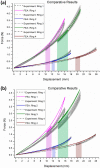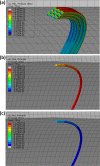Evaluation of a New Approach for Modeling Full Ring Stent Bundles with the Inclusion of Manufacturing Strains
- PMID: 31317366
- PMCID: PMC6927927
- DOI: 10.1007/s10439-019-02322-0
Evaluation of a New Approach for Modeling Full Ring Stent Bundles with the Inclusion of Manufacturing Strains
Abstract
Ring stent bundles have been used in several biomedical stent-graft devices for decades, yet in the published literature, the numerical models of these structures always present significant simplifications. In this paper, a finite element (FE) ring stent bundle has been developed and evaluated with a combination of beam and surface elements. With this approach, the shape, the global stiffness and the strains of the structure can all be well predicted at a low computational cost while the approach is suitable for application to non-symmetrical, patient-specific implant simulations. The model has been validated against analytical and experimental data showing that the manufacturing strains can be predicted to a 0.1% accuracy and the structural stiffness with 0-7% precision. The model has also been compared with a more computationally expensive FE model of higher fidelity, revealing a discrepancy of 0-5% of the strain value. Finally, it has been shown that the exclusion of the manufacturing process from the simulation, a technique used in the literature, quadruples the analysis error. This is the first model that can capture the mechanical state of a full ring stent bundle, suitable for complex implant geometry simulations, with such accuracy.
Keywords: Anaconda; Aneurysm; Finite element analysis; Ring bundle; Stent.
Figures








Similar articles
-
Investigation of Stent Implant Mechanics Using Linear Analytical and Computational Approach.Cardiovasc Eng Technol. 2017 Mar;8(1):81-90. doi: 10.1007/s13239-017-0295-0. Epub 2017 Feb 3. Cardiovasc Eng Technol. 2017. PMID: 28160266
-
Numerical simulation of patient-specific endovascular stenting and coiling for intracranial aneurysm surgical planning.J Transl Med. 2018 Jul 21;16(1):208. doi: 10.1186/s12967-018-1573-9. J Transl Med. 2018. PMID: 30031395 Free PMC article.
-
Patient-specific numerical simulation of stent-graft deployment: Validation on three clinical cases.J Biomech. 2015 Jul 16;48(10):1868-75. doi: 10.1016/j.jbiomech.2015.04.031. Epub 2015 May 1. J Biomech. 2015. PMID: 25979382
-
A novel sax-stent method in treatment of ascending aorta and aortic arch aneurysms evaluated by finite element simulations.J Med Vasc. 2017 Feb;42(1):39-45. doi: 10.1016/j.jdmv.2017.01.005. Epub 2017 Apr 18. J Med Vasc. 2017. PMID: 28705446 Review.
-
Computational structural modelling of coronary stent deployment: a review.Comput Methods Biomech Biomed Engin. 2011 Apr;14(4):331-48. doi: 10.1080/10255841003766845. Comput Methods Biomech Biomed Engin. 2011. PMID: 20589544 Review.
Cited by
-
Efficiently Simulating an Endograft Deployment: A Methodology for Detailed CFD Analyses.Ann Biomed Eng. 2020 Oct;48(10):2449-2465. doi: 10.1007/s10439-020-02519-8. Epub 2020 May 11. Ann Biomed Eng. 2020. PMID: 32394221 Free PMC article.
-
Analysing The Cross-Section of The Abdominal Aortic Aneurysm Neck and Its Effects on Stent Deployment.Sci Rep. 2020 Mar 13;10(1):4673. doi: 10.1038/s41598-020-61578-y. Sci Rep. 2020. PMID: 32170088 Free PMC article.
References
-
- Auricchio F, Taylor RL, Lubliner J. Shape-memory alloys: macromodelling and numerical simulations of the superelastic behavior. Comput. Methods Appl. Mech. Eng. 1997;146:281–312. doi: 10.1016/S0045-7825(96)01232-7. - DOI
-
- Azaouzi M, Lebaal N, Makradi A, Belouettar S. Optimization based simulation of self-expanding Nitinol stent. Mater. Des. 2013;50:917–928. doi: 10.1016/j.matdes.2013.03.012. - DOI
-
- Boukis, A. A comprehensive methodology for the experimental characterization and numerical modelling of nickel-titanium wires used in medical devices. PhD dissertation, University of Strathclyde, 2019.
-
- Bow, D. Mechanical analysis and simulation of the nitinol ring stent: assessing the radial strength, fatigue and compaction strains. PhD dissertation, University of Strathclyde, 2018.
-
- Circles in a Circle. http://www.packomania.com/, 2018.
MeSH terms
Grants and funding
LinkOut - more resources
Full Text Sources

